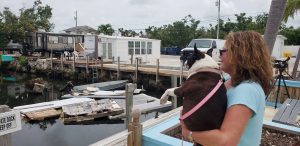
By Zachary Fagenson
MARATHON, Fla. (Reuters) – For eight months Terri Metter has made her home in a government trailer parked along a debris-clogged canal in the Florida Keys and she considers herself lucky since Hurricane Irma forced many of her former neighbors to move off the once-idyllic archipelago.

Terri Metter and her Boston Terrier Nikki overlook what’s left of destroyed trailers that fill a canal near a trailer park in Marathon, Florida, U.S., June 10, 2018. REUTERS/Zach Fagenson
Metter has been bunked down in temporary housing supplied by the Federal Emergency Management Agency (FEMA) since November, after the Category 4 storm, with winds of up to 130 miles per hour (209 kph), strafed nearby Cudjoe Key on Sept. 10, 2017.
“A few people are finding housing on boats or they’re sleeping on couches, but a lot of people who work here can’t afford to stay and it’s a sad thing,” said the 50-year-old bookkeeper and bartender in Marathon, a city made up of 13 tiny islands about 50 miles east of Key West and 115 miles southwest of Miami.
Though much of mainland Florida escaped major damage, the Keys were devastated. The resort islands, stretching southwest from the tip of the Florida Peninsula into the Gulf of Mexico, are connected by a single, narrow highway that runs along a series of bridges and causeways.
The hurricane destroyed almost 1,200 homes in Monroe County, which includes the Keys and parts of the mainland that are almost entirely in Everglades National Park. That figure excludes trailers, a popular form of housing in the Keys, and homes damaged so severely that owners simply abandoned them.
Overall, 84 people in Florida died as a result of Irma, and the region, including other southeastern states, suffered an estimated $50 billion worth of damage, according to the National Hurricane Center.
As the hurricane approached, Metter evacuated and stayed with family in Michigan, but returned a month later to see the devastation in her neighborhood, where only eight of 50 trailers and homes remained intact. Rotting debris and seaweed filled her home, and she decided rebuilding was the only option.
Others had no choice but to live elsewhere. A lack of affordable, safe housing forced many of those who work in the Keys’ numerous restaurants and hotels to move to the mainland, officials said.
“Folks are living in unlawful spaces that don’t meet code, unsafe spaces, and they have been doing it because they want to be there and it’s the only way they can afford to be there,” said Jaimie Ross, president of the Florida Housing Coalition.
Monroe County Commissioner George Neugent expects many who lost their homes or suffered major damage to never come back. In 2016, the county’s population totaled about 79,000, almost all of them residing in the Keys, according to the U.S. Census Bureau.
“I’m estimating between 15 and 25 percent of our population is going to be lost and we lose more and more every day,” he said.
To put a dent in the housing deficit, Monroe County has teamed with private developers and donors on a plan to build homes capable of withstanding 200 mile-per-hour winds that are affordable for hospitality workers. Florida Governor Rick Scott and state lawmakers are also weighing a proposal for 1,300 new housing units for workers in the Keys.
The construction cannot come fast enough as the region braces for what this year’s hurricane season, which began June 1, will bring to the region.
The National Oceanic and Atmospheric Administration’s Climate Prediction Center expects the season to be a near-normal to above-normal season in terms of the number and intensity of storms.
The long recovery from Irma and the previous hurricane season has raised doubts with many, said Neil Curran, 45, a contractor and waiter who lost the 42-foot sailboat where he lived off Key West during last year’s storm.
While Curran is renting a new boat after bouncing around more than a dozen FEMA-funded hotel rooms, he said he knew of at least two dozen friends who have left the islands, and more on the cusp of leaving.
“Over the summer, we’re going to see a pretty big mass exodus,” he said.
(Reporting by Zachary Fagenson; editing by Ben Klayman, Frank McGurty and G Crosse)







